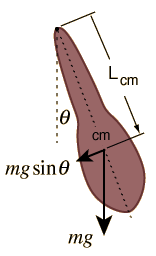Oscillations - Online Test
If the restoring force of a vibrating or oscillatory system is proportional to the displacement
of the body from its equilibrium position and is directed opposite to the direction of displacement,
the motion of the system is simple harmonic and it is given by
where A, the maximum value of the displacement, is called the amplitude of the motion. If
T is the time for one complete oscillation, then
x(t + T) = x(t)
or
As angular frequency is given by and
Then,time period of oscillation of mass m is given by

Torque;,a= angular accleration
so Time period T is :
T = 2π
In real oscillators, friction, or damping, slows the motion of the system. Due to frictional force, the velocity decreases in proportion to the acting frictional force.
where the c is the damping constant
The forces on the system is restoring force and the damping force is where 'k' is the force constant and 'b' is the damping constant
The net force is F= m*a which is equal to the sum of restoring force and the damping force is
The damped natural frequency fd is related to the natural frequency fn by a relation
where damping ratio is <= 1
so the fd is less than the natural frequency
